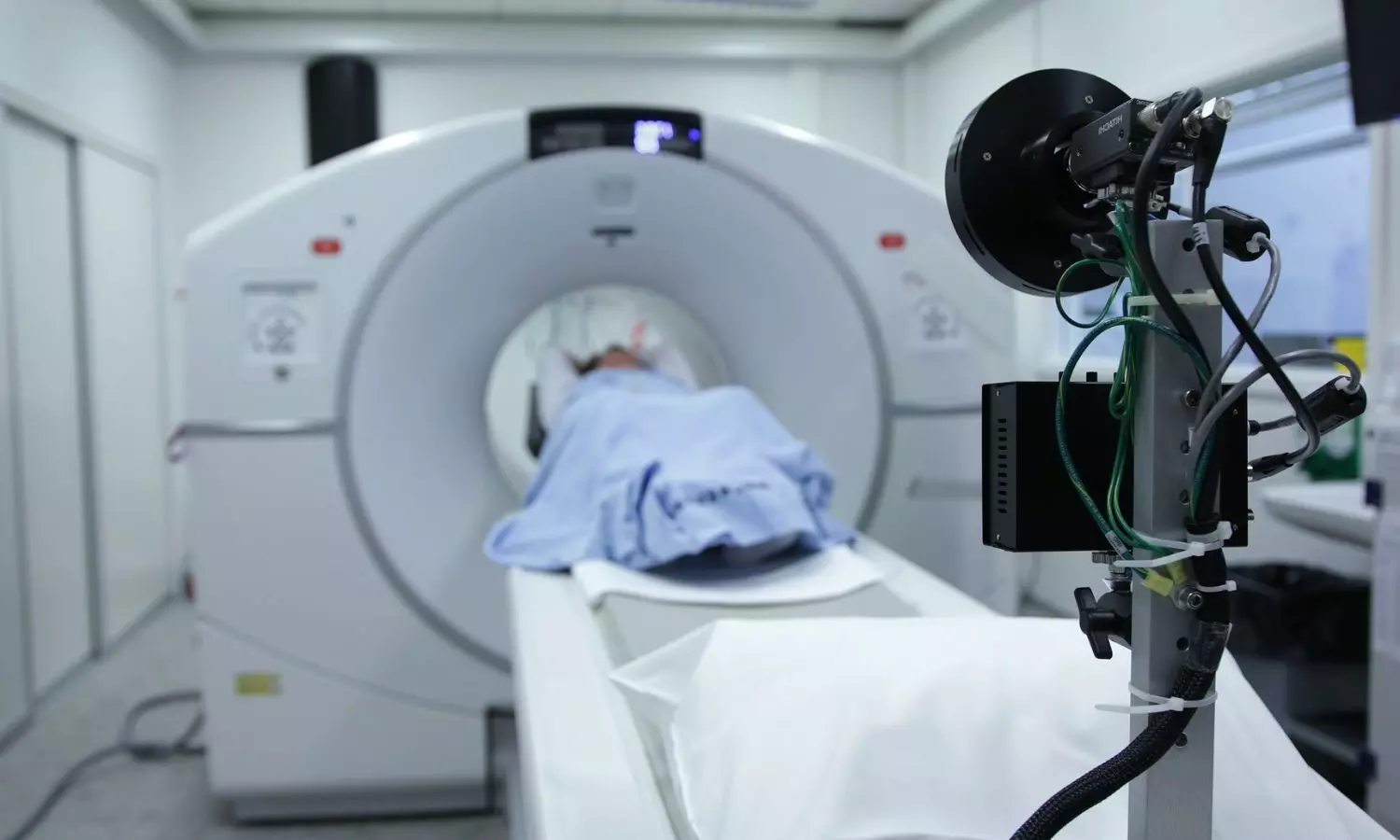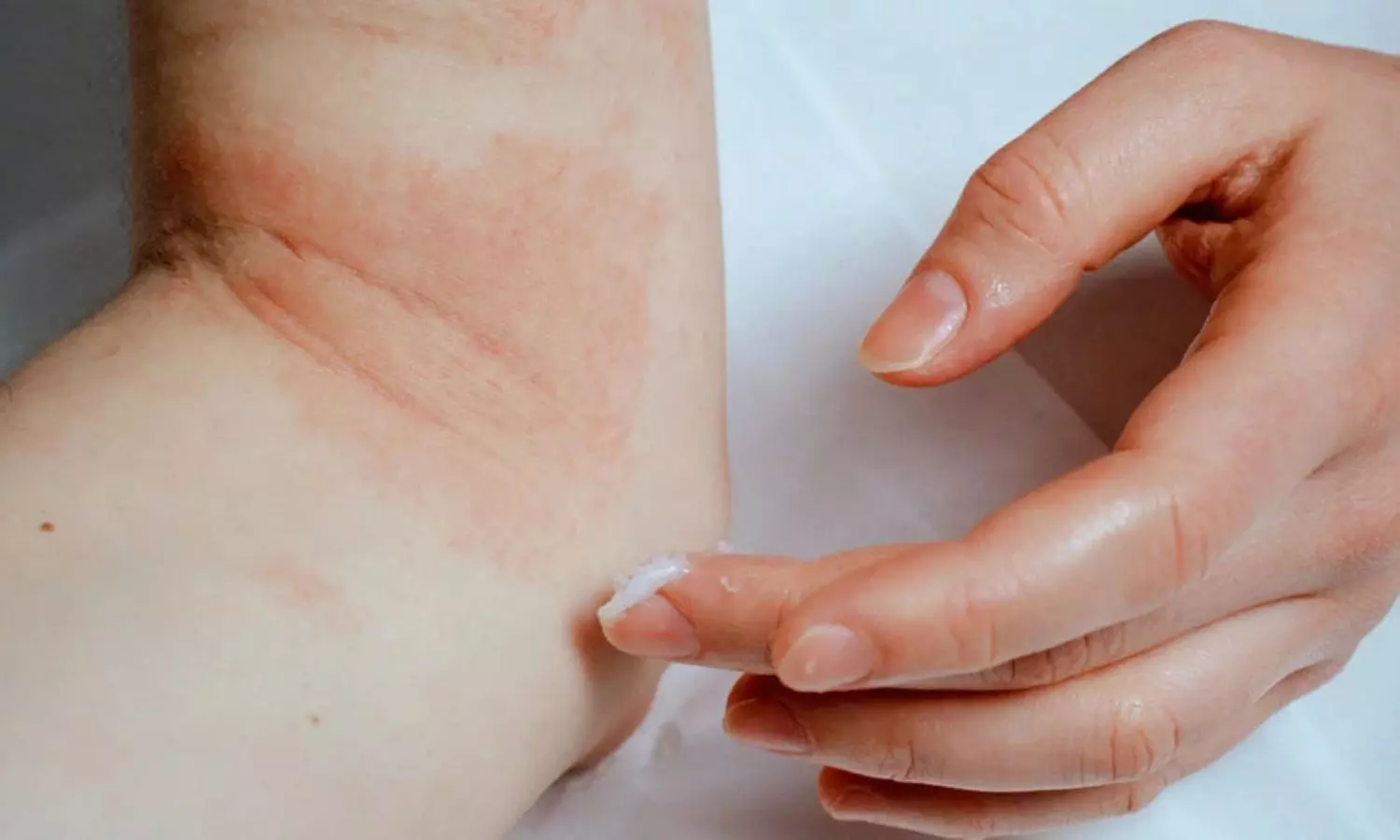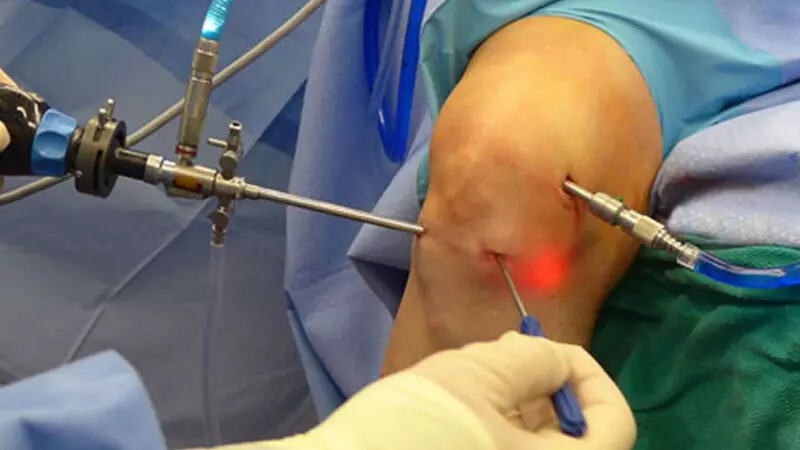Study traces an infectious language epidemic
Powered by WPeMatico
Powered by WPeMatico
Powered by WPeMatico
Powered by WPeMatico
Powered by WPeMatico
Powered by WPeMatico

Most people with early-stage glaucoma don’t know they have it, even though early treatment is key to reducing vision loss. While detecting a subtle increase in eye pressure helps doctors to diagnose glaucoma, it’s challenging to monitor continuously, especially with the variety of temperatures eyes experience. Now, researchers in ACS Applied Materials & Interfaces report a prototype “smart” contact lens that measures eye pressure accurately, regardless of temperature.
About three million people in the U.S. have glaucoma, a group of diseases that damage the optic nerve and lead to vision loss, according to the Centers for Disease Control and Prevention. Doctors use flinch-inducing “air puff tests” during eye exams to take one-time measurements of eye pressure. A slight elevation in pressure, an otherwise imperceptible symptom caused by fluid buildup around the cornea, can lead to a glaucoma diagnosis. Researchers have been testing ways to continuously and more comfortably detect these tiny fluctuations in pressure, such as contact lenses that transmit signals to receptor glasses. However, changing temperatures-like stepping outside into cold weather-can throw off the lenses’ measurements. So, Dengbao Xiao and coworkers wanted to develop a contact lens that accurately measures and wirelessly transmits real-time signals about eye pressure across a wide range of temperatures.
First, Xiao and the team designed two miniature spiral circuits, each with a unique natural vibration pattern that would change when stretched by minute amounts, such as with changes to an eye’s pressure and diameter. To create pressure-detecting contact lenses, the researchers sandwiched these tiny circuits between layers of polydimethylsiloxane, a typical contact lens material. Then they wirelessly read the embedded circuits’ vibration patterns by holding a coil near the lens that was connected to a computer. The transmitted signals were unaffected by tests meant to mimic eye movement, extended exposure to moisture (to simulate damp conditions in the eye), and daily wear and tear.
In laboratory tests, the researchers placed the new lenses on three individual pig eye specimens while controlling the ocular pressures and temperatures. The contact lenses monitored and wirelessly transmitted pressure data from 50 to 122 degrees F. When pressures were calculated from the signal of only one circuit in the lens, the results deviated up to 87% from the true values. However, when information from both circuits was used, the pressure readings differed by only 7% from the true value because the combination removed temperature-related errors. The researchers say that their dual-circuit “smart” lens design has potential to be used for accurate early detection and monitoring of glaucoma, even in a wide range of temperatures.
Reference:
Xu Li, Wei Chen, Hongyang Li, Biwen Shen, Jiangang He, Huanlin Gao, Fengjiao Bin, Hui Li, and Dengbao Xiao, Temperature Self-Compensating Intelligent Wireless Measuring Contact Lens for Quantitative Intraocular Pressure Monitoring, ACS Applied Materials & Interfaces, https://doi.org/10.1021/acsami.4c02289.
Powered by WPeMatico

A comprehensive retrospective analysis that spanned over a decade shed light on the incidence, risk factors and management strategies associated with radiation cystitis in prostate cancer patients who undergo pelvic radiotherapy. The findings of the study were published in the Urology journal.
The study was conducted using the extensive PearlDiver™ Mariner database and examined the records of a total of 274,865 patients who received radiotherapy for prostate cancer from 2011 and 2022. The primary objective was to determine the overall incidence of radiation cystitis and analyze the factors that contribute to its development.
The results revealed that 17.7% of patients experienced hematuria following radiotherapy, while 2.8% were diagnosed with radiation cystitis. Among the patients diagnosed, approximately 30% underwent diagnostic or therapeutic endoscopic interventions. Only a small fraction of patients, about 0.76%, opted for endovascular embolization, while 1.95% required cystectomy. Hyperbaric oxygen therapy was found to be the most prevalent treatment option that was administered to 16.67% of patients, with a significant upward trend observed over the study period.
Further analysis utilizing multivariate logistic regression unveiled several significant risk factors associated with radiation cystitis. Obesity, smoking and diabetes were identified as significant contributors with odds ratios of 1.29, 1.27 and 1.32 respectively, all with p-values below 0.001. These findings underline the importance of addressing modifiable risk factors in the management and prevention of radiation-induced complications.
The findings of this study emphasized the clinical significance of radiation cystitis as a rare yet impactful complication following pelvic radiotherapy for prostate cancer. Despite advancements in treatment modalities, the incidence of radiation cystitis remained stable throughout the study period which highlighted the need for continued research and innovative approaches to reduce its occurrence and improved patient outcomes.
The comprehensive approach of the study provides valuable insights for clinicians in risk assessment, treatment selection and patient counseling. Clinicians can tailor interventions to individual patient profiles, optimizing therapeutic efficacy and minimizing adverse effects by identifying key risk factors and evaluating management strategies. The integration of these findings into clinical practice holds the potential to enhance the overall quality of care for prostate cancer patients undergoing radiotherapy by ultimately enhancing treatment outcomes and patient well-being.
Source:
Bologna, E., Licari, L. C., Franco, A., Ditonno, F., Manfredi, C., De Nunzio, C., Antonelli, A., De Sio, M., Coogan, C., Vourganti, S., Leonardo, C., Simone, G., & Autorino, R. (2024). Incidence and Management of Radiation Cystitis After Pelvic Radiotherapy for Prostate Cancer: Analysis from a National Database. In Urology. Elsevier BV. https://doi.org/10.1016/j.urology.2024.04.035
Powered by WPeMatico

USA: In a groundbreaking development in dermatology, the efficacy, safety, and long-term disease control of Ruxolitinib Cream among adolescents with Atopic Dermatitis (AD) have been showcased through pooled results from two randomized Phase 3 studies. The findings of these studies offer hope to millions of adolescents grappling with the distressing symptoms of AD.
The study, published in the American Journal of Clinical Dermatology, showed that 1.5% ruxolitinib cream may result in significant anti-inflammatory and antipruritic effects within the subset of adolescent patients with atopic dermatitis. Long-term, as-needed utilization of the drug is well tolerated and maintains disease control.
Atopic Dermatitis, commonly known as eczema, is a chronic inflammatory skin condition characterized by intense itching, redness, and dryness. While it affects individuals of all ages, adolescents often experience profound psychological and social impacts due to the visible nature of the condition.
A topical formulation of ruxolitinib, a Janus kinase (JAK) 1/JAK2 inhibitor, demonstrated efficacy and safety among adolescents/adults in two phase 3 studies (TRuE-AD1/TRuE-AD2). Lawrence F. Eichenfield, Rady Children’s Hospital, San Diego, CA, USA, and colleagues aimed to describe the efficacy and safety of 1.5% ruxolitinib cream versus vehicle and long-term disease control of ruxolitinib cream among adolescents aged 12–17 years from pooled phase 3 study data.
For this purpose, the researchers included patients [≥ 12 years old with AD for ≥ 2 years, Investigator’s Global Assessment score (IGA) 2/3, and 3–20% affected body surface area (BSA) at baseline]. They were randomized in a 2:2:1 ratio to ruxolitinib cream (0.75%/1.5%) or vehicle for eight weeks of continuous use followed by a long-term safety (LTS) period of up to 52 weeks with as-needed use.
Patients who were originally applying the vehicle were randomized 1:1 to 0.75%/1.5% ruxolitinib cream. Efficacy measures in the 8th week included ≥ 75% improvement in Eczema Area and Severity Index (EASI-75), IGA treatment success (IGA-TS; i.e., score of 0/1 with ≥ 2-grade improvement from baseline), and ≥ 4-point improvement in itch numerical rating scale (NRS4).
Disease control measures during the LTS period included an IGA score of 0 (clear) or 1 (almost clear) and a percentage that affected BSA. Safety assessment was done throughout the study.
The study revealed the following findings:
· Of 1249 randomized patients, 19.6% were 12–17 years. Of these, 45 patients were randomized to vehicle and 92 patients to 1.5% ruxolitinib cream.
· A total of 75.9% of patients continued on 1.5% ruxolitinib cream in the LTS period [89.1% continued on 1.5% ruxolitinib cream; 48.9% patients on the vehicle were reassigned to 1.5% ruxolitinib cream], and 79.8% of these patients completed the LTS period.
· At week 8, substantially more patients who applied 1.5% ruxolitinib cream versus vehicle achieved IGA-TS (50.6% versus 14.0%), NRS4 (52.1% versus 17.4%), and EASI-75 (60.9% versus 34.9%).
· The mean reduction in itch NRS scores was significantly greater in patients applying 1.5% ruxolitinib cream versus vehicle from day 2 [− 0.9 versus −0.2].
· During the LTS period, mean trough steady-state ruxolitinib plasma concentrations at weeks 12/52 were 27.2/15.5 nM.
· The percentage of patients achieving an IGA score of 0 or 1 was sustained or further increased with 1.5% ruxolitinib cream; the mean affected BSA was generally low (< 3%; i.e., mild disease).
· Through 52 weeks, application site reactions occurred in 1.8% of adolescent patients applying 1.5% ruxolitinib cream at any time; no patients had severe adverse events.
· There were no serious infections, major adverse cardiovascular events, malignancies, or thromboembolic events.
The findings suggest that in adolescents with atopic dermatitis, 1.5% ruxolitinib cream demonstrated antipruritic and anti-inflammatory effects, which were comparable with those in the overall study population.
Furthermore, adolescents maintained disease control over 52 weeks with as-needed use, and ruxolitinib cream was well tolerated.
Reference:
Eichenfield, L.F., Simpson, E.L., Papp, K. et al. Efficacy, Safety, and Long-Term Disease Control of Ruxolitinib Cream Among Adolescents with Atopic Dermatitis: Pooled Results from Two Randomized Phase 3 Studies. Am J Clin Dermatol (2024). https://doi.org/10.1007/s40257-024-00855-2
Powered by WPeMatico

Preterm infants supported with a multicomponent intravenous lipid emulsion saw improved brain development compared to those given a single-fat source, a new study finds. The research will be presented at the Pediatric Academic Societies (PAS) 2024 Meeting, held May 3-6 in Toronto.
Soybean-only lipid emulsions traditionally have been used in neonatal intensive care units to provide intravenous nutritional support to preterm infants, according to researchers. This study investigated the effects of newer multicomponent lipid emulsions, with fat sources derived from soybeans, olives, coconuts, and fish oil, on preterm brain development compared to soybean-only.
Researchers evaluated the impact of a variety of intravenous lipid emulsions on preterm brain development using magnetic resonance imaging, magnetic resonance spectroscopy, and early neurobehavioral assessments from 89 U.S. preterm infants born at or before 32 gestational weeks.
Researchers found that preterm infants receiving the multicomponent lipid emulsion demonstrated improved regional brain growth and biochemical markers of neuronal integrity, as well as superior neurobehavioral regulation, by term-corrected age. These findings could be due to the potential anti-inflammatory and antioxidant properties of the newer multicomponent lipids, the authors postulate.
“Preterm births account for more than 10% of all births in the United States, and the majority of very preterm infants experience neurological issues later in life,” said Katherine Ottolini, MD, attending neonatologist in the Developing Brain Institute at Children’s National Hospital and presenting author. “Early lipid intake is critical for preterm brain development, and our findings suggest that reformulated intravenous lipid products have the potential to enhance neurodevelopment in this particularly vulnerable population.”
Study authors recommend ongoing research on reformulated intravenous lipid emulsions be conducted to assess long-term neurodevelopmental effects.
Powered by WPeMatico

Recently published study compared the analgesic efficacy of ultrasound-guided genicular nerve block (GNB) with adductor canal block (ACB) in patients undergoing arthroscopic anterior cruciate ligament reconstruction (ACLR). The randomized, double-blind study included 38 adult patients, with 19 in each group. The primary outcome was Numerical Rating Scale (NRS) pain scores over 24 hours, and the secondary outcome included the duration of analgesia and 24-hour morphine consumption. The study found that NRS scores at rest and physical activity at 24 hours were similar in both groups. The mean time to rescue analgesia and 24-hour morphine consumption was also comparable in both groups, indicating that ultrasound-guided GNB has an analgesic efficacy similar to ultrasound-guided ACB for patients undergoing arthroscopic ACLR.
Importance of Postoperative Analgesia in ACLR and Comparison of GNB and ACB –
The study emphasizes the importance of postoperative analgesia in ACLR, highlighting the benefits of early mobilization and patient satisfaction. The authors utilized US-guided GNB and ACB and found that both techniques provide comparable postoperative analgesia for ACLR patients. Although GNB provides motor-sparing and selectively blocks articular branches, the study findings suggest that it has similar analgesic efficacy to ACB, a relatively familiar technique. Additionally, the study highlighted the potential limitations, including the small sample size and high standard deviation. The authors recommended more randomized controlled trials with a larger sample size to further understand the safety and efficacy of GNB after knee surgery. Overall, the study contributes valuable insights into the analgesic efficacy of GNB and ACB for patients undergoing ACLR, indicating their comparable effectiveness in postoperative pain management.
Key Points –
– The study emphasizes the importance of postoperative analgesia in ACLR, highlighting the benefits of early mobilization and patient satisfaction. The authors utilized US-guided GNB and ACB and found that both techniques provide comparable postoperative analgesia for ACLR patients. Although GNB provides motor-sparing and selectively blocks articular branches, the study findings suggest that it has similar analgesic efficacy to ACB, a relatively familiar technique. Additionally, the study highlighted the potential limitations, including the small sample size and high standard deviation. The authors recommended more randomized controlled trials with a larger sample size to further understand the safety and efficacy of GNB after knee surgery.
– Overall, the study contributes valuable insights into the analgesic efficacy of GNB and ACB for patients undergoing ACLR, indicating their comparable effectiveness in postoperative pain management.
Reference –
Sujatha, Sandeep S. N.; Gupta, Kapil1; Guria, Sushil; Chhabra, Priyanka H.. Comparison of genicular nerve block with adductor canal block for postoperative pain management in patients undergoing arthroscopic knee ligament reconstruction: A randomised controlled trial. Indian Journal of Anaesthesia 68(5):p 454-459, May 2024. | DOI: 10.4103/ija.ija_994_23.
Powered by WPeMatico
